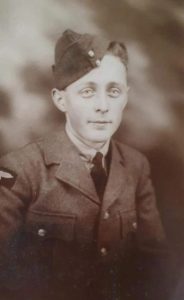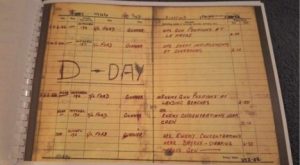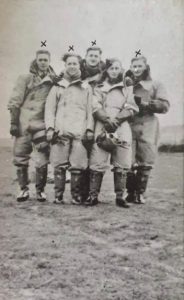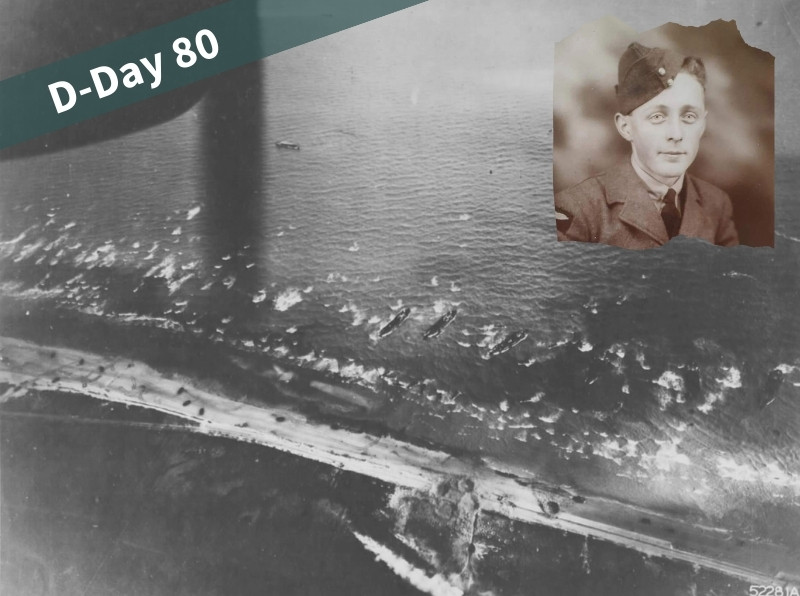Stories from our community for the 80th anniversary of the Normandy landings
In part 4 of our D-Day 80 community stories series, we meet James Tough Gibson, whose squadron was involved in the D-Day landings of 6 June 1944. Thanks to James’s daughter, Joann, who shared fascinating documentation relating to James’s service during the war, we gained vital insight into his squadron’s operations.
Operation Overlord: experiencing D-Day from the air

Born in 1922, Joann’s father, James Tough Gibson, was from Leith, the port district of Edinburgh located north of the city. In civilian life James was a clerk, but this would soon be interrupted by the advent of war.
James served with the Royal Air Force during WWII and appears in our Royal Air Force Nominal Index of Airmen and Airwomen, 1918-1975 collection. The collection provides simple details on RAF personnel, including their numbers and enlistment range. These are great clues for family historians and can help you research other military collections. James’s entry notes that he enlisted between September 1939 and February 1940. It also contains the word ‘Militia’, indicating that he was conscripted under the Military Training Act 1939, where the term ‘militiamen’ was revived.
According to Joann, James served as a Wireless Operator with Bomber Command, passing his training as a Wireless Operator in 1941 and an Air Gunner the following year. He was part of No. 180 Squadron, which was equipped with North American B-25 Mitchell bombers. Between 1943 and 1944, they operated out of RAF Dunsfold in Surrey.
180 squadron history and B-25 photos – maybe just use photo.
The squadron prepared for D-Day by flying daylight raids on targets in France and Belgium, followed by a two-week bombing course in April 1944. For D-Day, the squadron was involved in night-bombing missions, lasting until October, targeting troops and transport links, amongst other tactical objectives, supporting the breakout of Normandy.
James’s Observer’s and Air Gunner’s Flying Log Book, provided by Joann, reveals fascinating details of the missions No. 180 Squadron carried out.
On 6 June 1944, the day of the Normandy invasion, a Mitchell aircraft, number 190, piloted by Squadron Leader Ford, carried out the following sorties:
| Time | Duty | Operations |
| 02:00 | Gunner | Enemy gun positions at landing beaches. |
| 07:00 | Gunner | Enemy concentrations near Caen. |
| 12:00 | Gunner | Enemy concentrations near Bayeux – strafing. |

As Operation Overlord continued and Allied forces sought to push into France, number 180 Squadron was kept busy, taking part in the attack on Panzer Group West’s HQ on 10 June 1944.
James survived the war and married Hilda Hellingsworth in 1952. According to Joann, her mother served with the Women’s Auxiliary Air Force during WWII:
‘My Mum joined at 17, passed her driving test in 4 days. And drove trucks and took the airmen to their planes. She was in Tain, in Scotland and served with many Polish Airmen.’
Reflecting on her father’s service, Joann highlighted the difficulty many veterans had getting to grips with the part they played during the war: ‘I am very proud of my Dad serving his country…He never talked about what he did during the war, but I remember him going to Coventry in the late 1960s, which I thought was a weird place to go. It wasn’t till I was older that I realised the significance of Coventry. I really think he went to justify to himself what he did during the war.’
D-Day 80: keeping their stories of courage and bravery alive for future generations

The D-Day invasions shaped the course of WWII and, ultimately, history, and William, Norman, Raymond and James all played their part in this pivotal moment. Their bravery, courage and determination in the face of the unknown is inspiring and a testament to their generation’s sacrifices, which we must remember and honour. We’d like to thank each of our community members for sharing their family stories with us.
FWR Tip: Why not create a virtual Memorial for your military ancestors with Forces War Records? It’s a great place to save the records you find during your research and keep the memories and stories of your military family members alive.
If you’ve been inspired by our D-Day 80 series to research your ancestors’ connection to D-Day or their service in WWII, start searching our collections today. We’ve even created a handy video on how to begin your searches.
This blog is largely based on the information provided by the community member and records where available.
Cover image: Aerial view of the D-Day invasions ©NARA available in our WWII US Air Force Photos collection. Image of James Tough Gibson provided by Joann Arthur.
Sources
Aircrew Remembered, 2 Tactical Airforce (2TAF) 180 Squadron RAF Missing Presumed Killed, accessed June 2024.
HistoryOfWar.org., No. 180 Squadron (RAF): Second World War, accessed June 2024.
Imperial War Museums, How D-Day Was Fought From The Air, accessed June 2024.
UK Parliament, Conscription: the Second World War, accessed June 2024.


